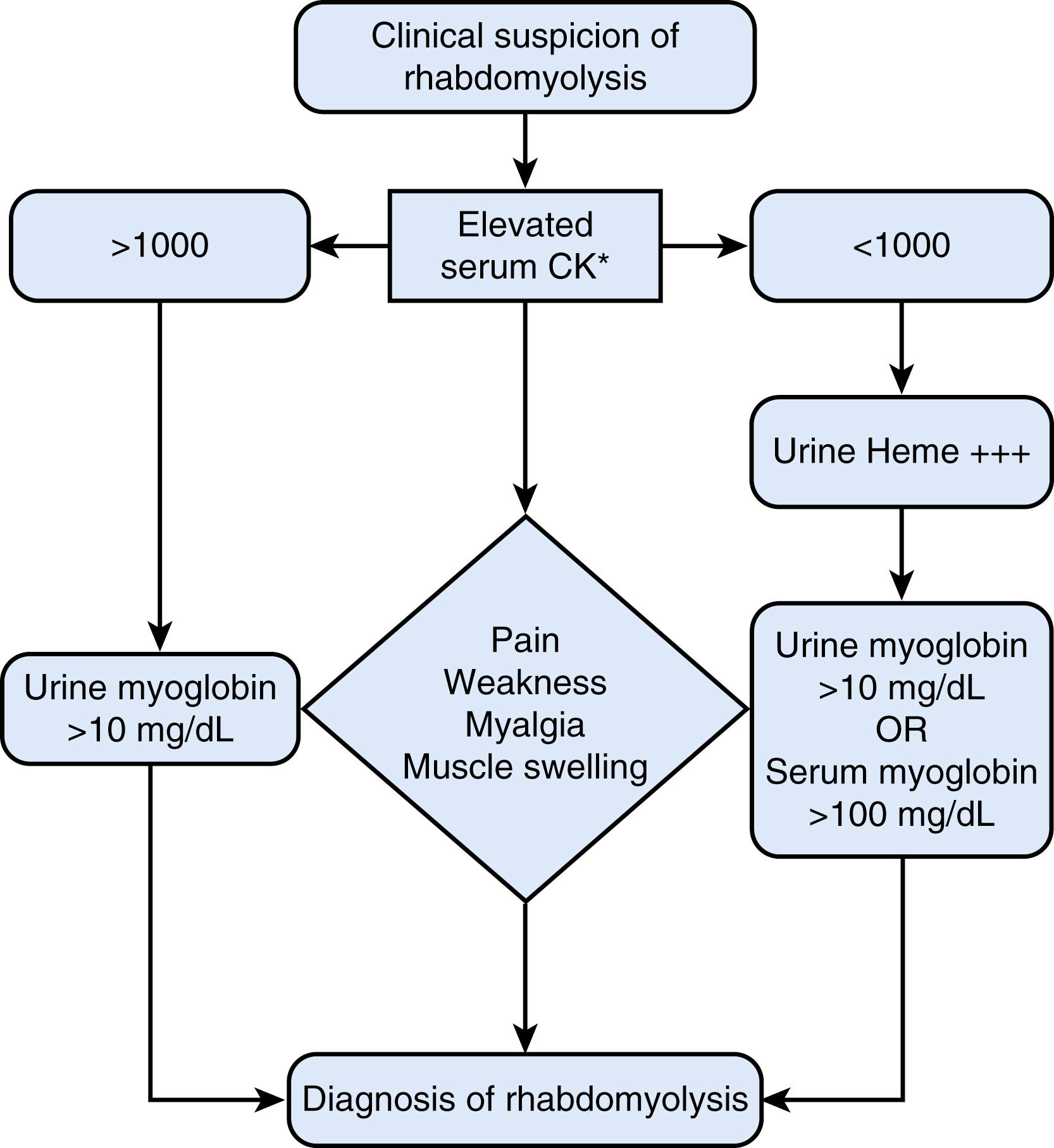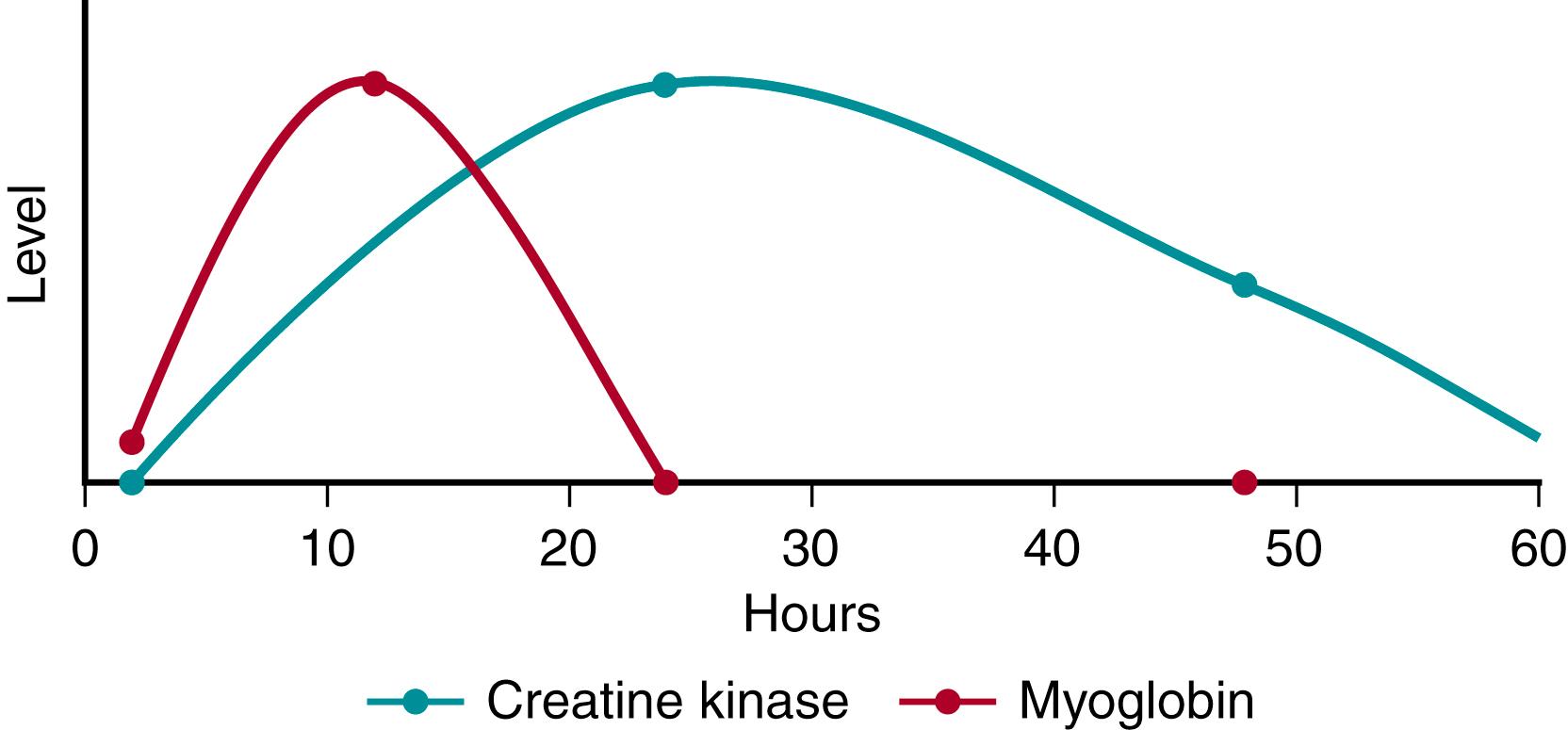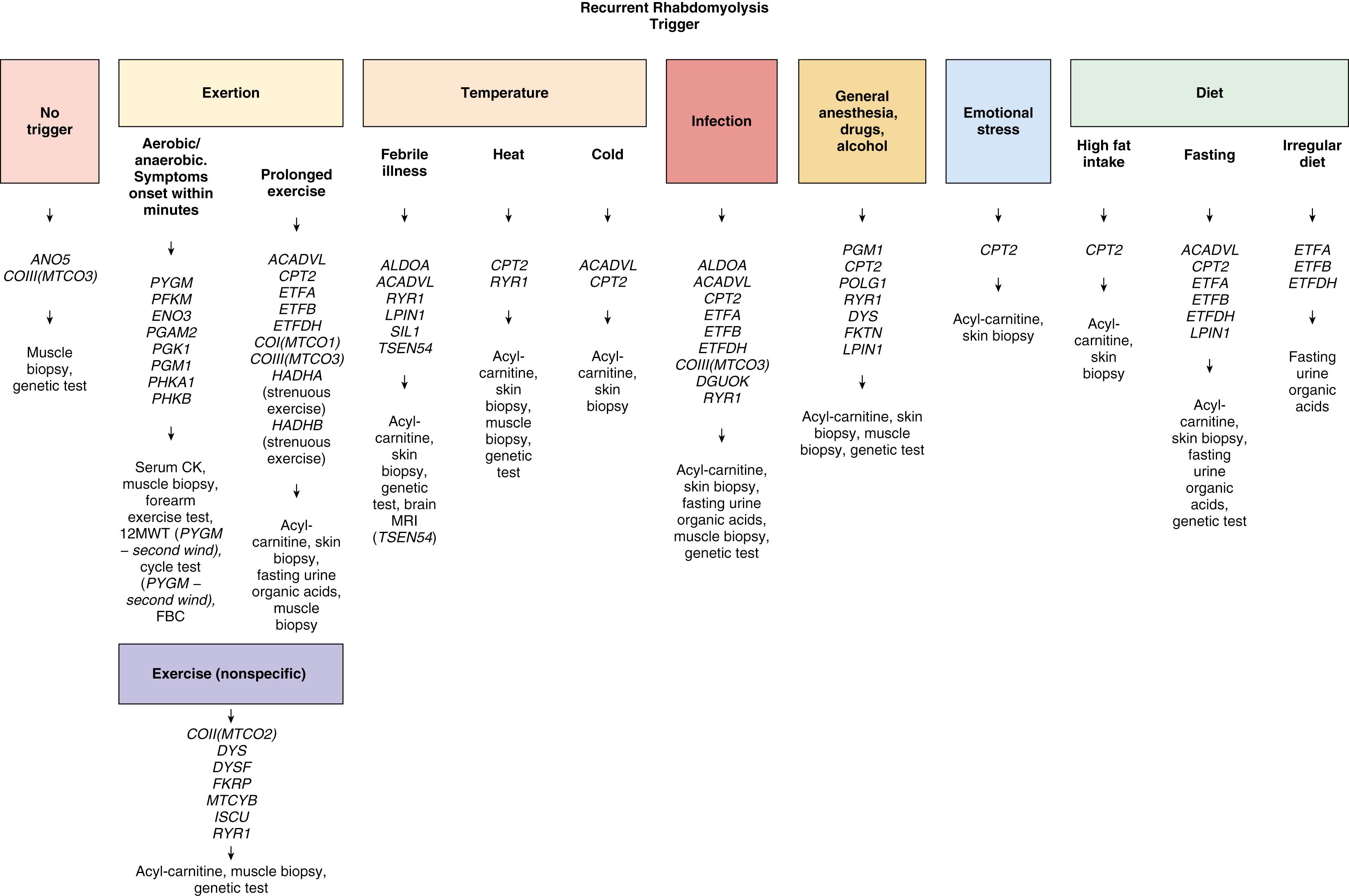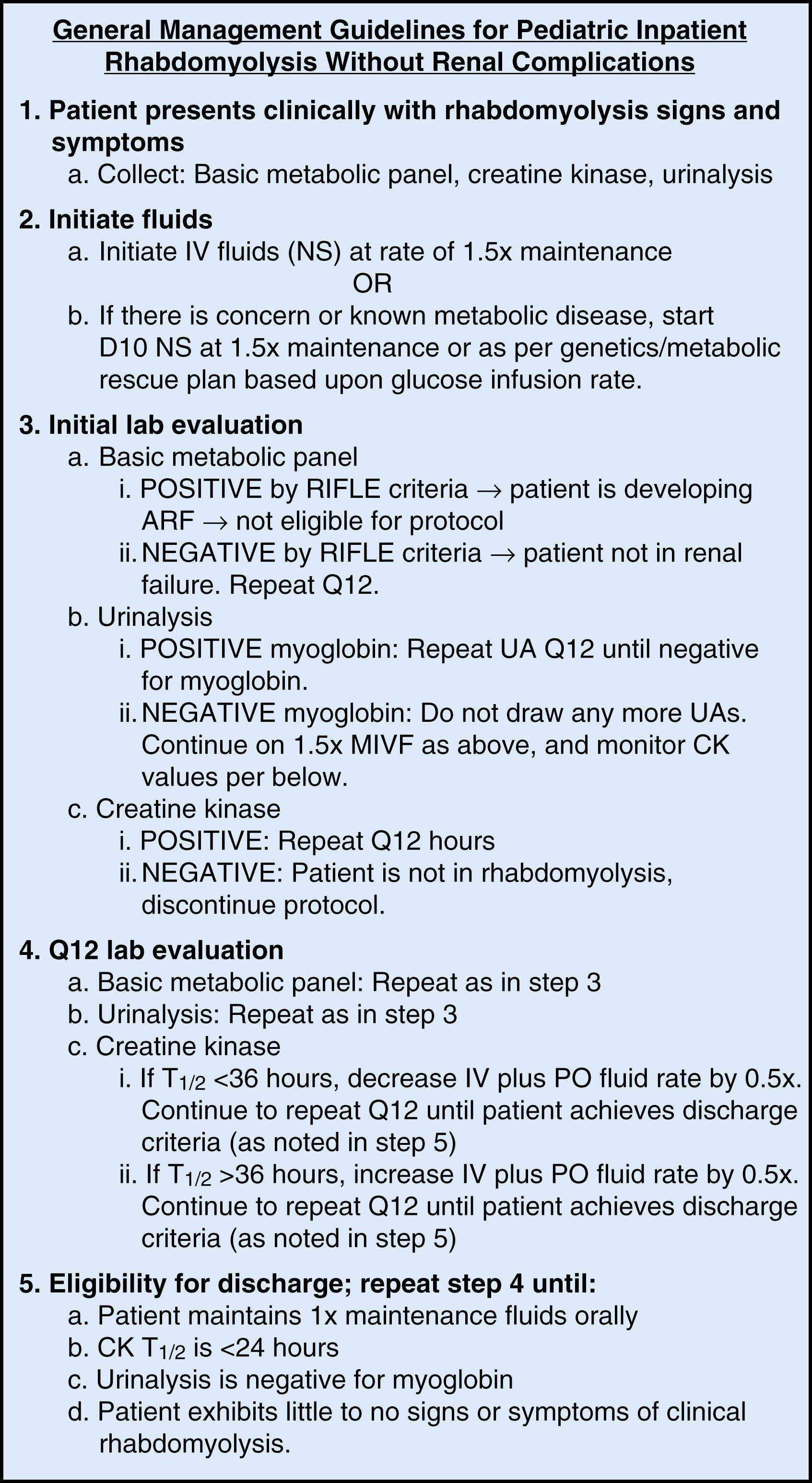Physical Address
304 North Cardinal St.
Dorchester Center, MA 02124
Rhabdomyolysis is an acute muscle injury resulting in myocyte cell death with subsequent release of toxic intracellular compounds producing muscle and systemic symptoms. This differs from hyperCKemia, in which there is elevated creatine kinase in the serum secondary to dysfunction of the myocyte sarcolemma. These diagnoses represent a broad category of disease processes with a large differential diagnosis. The difficulty lies in differentiating between the two processes given that the treatment of the former may include hospital admission while the latter often only requires supportive care.
The surrogate biomarker for rhabdomyolysis , creatine kinase (CK) , is a poor substitute because it is not possible to differentiate, based upon this value, between rhabdomyolysis and hyperCKemia. The generally accepted definition of rhabdomyolysis includes an elevation of CK either >1,000 IU/L or greater than five times the upper limit of normal in a clinical context of acute muscle weakness, myalgia, and muscle swelling ( Fig. 36.1 ).

There are exceptions; focal rhabdomyolysis may result in lower CK levels with the same underlying pathologic processes. Additionally, levels above the limit of 1,000 I/U can be found in patients with acute denervating diseases, in patients with hyperCKemia from intense exercise, and in patients with non-muscle-related diseases. A diagnosis of rhabdomyolysis should not be considered in patients without acute clinical symptoms and acute CK changes from the baseline value. Levels over 5,000 I/U are rarely found in acute or chronic non-muscle-related diseases.
In addition to muscle damage and pain, toxins released into the circulation from the myocyte damage can lead to systemic problems including cardiac arrythmias, encephalopathy, and, most commonly, acute kidney injury.
HyperCKemia is diagnosed when the serum elevation of CK is beyond the upper limits for age, gender, race, and muscle mass but in the absence of associated symptoms. Given the sensitive CK fluctuations with exercise, the assessment of hyperCKemia needs to be taken into consideration with the patient’s hydration status, previous activity, and timing from any possible inciting event. CK typically begins to increase 24 hours after the onset of a muscle injury or stress, peaks at around 24–36 hours, and, in a monophasic illness, starts to decline. The normal half-life of CK, in a patient without renal failure, is between 24 and 48 hours ( Fig. 36.2 ).

Careful consideration of laboratory norms for CK is essential in interpreting elevated levels during an acute event because normal values correlate to overall muscle bulk, race, and gender. Additionally, frequent exercise in athletes can lead to persistently elevated CK (350–500 IU/L) during training. Obtaining a baseline CK level after a period of rest is required. There is no risk of renal damage in hyperCKemia given that there is no myoglobin released into the circulation.
Myoglobinuria is the presence of elevated myoglobin levels in the urine. Myoglobin is a chemical compound that carries oxygen in the myocyte. Upon damage to the cell membrane, it can be released into the blood at higher levels than typically seen. When levels are >0.5–1.5 mg/L, it saturates the serum haptoglobin and α 2 -immunoglobulin and the excess is filtered by the glomerulus. Myoglobin sequesters fluid, leading to hypovolemia and renal vasoconstriction. It can release the free iron, which may damage the renal tubules, or it may react directly with the lipid membrane of the kidney, resulting in damage to the proximal tubules.
While there are direct laboratory detection methods, the time to obtain results is not rapid enough to use this value to direct treatment; urine heme when not in the presence of red blood cells is frequently used as a surrogate marker to indicate myoglobinuria in the appropriate acute setting and when clinically suspected. In this situation, the urine red blood cell (RBC) count should be checked to determine if the heme +++ results in myoglobin or hematuria. Measuring myoglobin levels remains a valuable differentiator between rhabdomyolysis and hyperCKemia. Normal urine myoglobin levels are <10 mg/dL (and 100 mg/dL in blood); elevated levels indicate rhabdomyolysis.
The typical red- or tea-colored urine described in rhabdomyolysis is not always noted and requires a urine myoglobin concentration >100 mg/dL. In a patient who has been fluid resuscitated, the urinary dilution can mask both the visible and laboratory detection of myoglobinuria. It is important to collect samples during the acute phase of presentation or when fluids are weaned because the urine can then become positive.
Myositis is an inflammatory process in the muscle not related to underlying chronic apoptotic muscle disease. In patients with myositis, there is an underlying immune or rheumatologic process resulting in inflammatory cells causing muscle damage, which involves the myocyte membrane. This is in contrast with primary (genetic) muscle diseases in which there can be signs of inflammation secondary to the apoptotic process of cell death. In some cases, such as dysferlinopathies, these can be mistaken for an inflammatory myopathy on the biopsy. However, in isolated myositis, there is not the same release of other biomarkers from the myocytes into the serum as seen in acute rhabdomyolysis. Additionally, other than infectious myositis, most of these disease processes are subacute to chronic in nature with only rare presentations as acute rhabdomyolysis.
The first part of the history of a patient with possible rhabdomyolysis is the history of the acute episode, while the second part is to evaluate for an underlying etiology. The acute history will help differentiate the potential for rhabdomyolysis from other causes of pain and weakness ( Table 36.1 ); once diagnosed, the etiology of the rhabdomyolysis needs to be evaluated.
| Disease | Typical Weakness Pattern | Pain Pattern | Other Symptoms |
|---|---|---|---|
| Rhabdomyolysis | Diffuse or muscles used with exertion, often larger muscles are preferred | Same as muscle pain | Dark or red urine Elevated CK |
| Guillain-Barré syndrome | Ascending weakness | Neuropathic pain (typically distal) | May have areflexia, autonomic symptoms |
| Myasthenia gravis | Proximal weakness with/without ocular or bulbar symptoms, often fatigable | No pain | Pupillary-sparing fatigable weakness |
| Botulism | Descending weakness that involves pupils | No pain | Often GI symptoms |
| Myalgia | In area of pain | Often muscle or joint pains, large muscles preferred | Often in association with other disease, CK is often normal |
| Psychogenic | May have non-neurologic pattern of weakness, weakness that varies based upon how it is examined, give-way weakness | Pain and weakness are not always congruent in a physiologic distribution | May have other features of a psychogenic illness Normal CK during an acute episode is not rhabdomyolysis |
| Nonrheumatologic connective tissue disease (e.g., Ehlers-Danlos syndrome) | Often no overt weakness | Pain is often after activity but more joint related than muscle | Normal CK during an acute episode May have a history of fatigue with endurance activity but normal strength |
A child with rhabdomyolysis may present with a variety of symptoms. Most patients present with muscle pain. The remaining 20% do not present with overt signs of muscle disease. Dark urine (myoglobinuria) may be reported in ∼5% of patients; an even smaller number develop acute renal failure.
Patients with focal muscle swelling may develop a compartment syndrome resulting in local neurovascular features and may develop more systemic disease such as acute kidney injury or encephalopathy with associated seizures, somnolence, and/or other cognitive changes. Cardiac arrythmias may also be present.
Given the half-life and timing of the typical peak for both myoglobin and CK, the timing of the disease onset is important. Patients presenting early in their course may not have an elevation of their CK, whereas patients who have milder symptoms or do not present during the acute episode may have normal or near-normal lab results. Symptoms of previous episodes for which the patient did not seek clinical care can suggest an underlying etiology; any signs of possible muscle disease including features of muscle dysfunction (weakness, cramps, pain) at baseline as well as during different types of activity (anaerobic vs aerobic and concentric vs eccentric exercise) as well as family history and inciting events or risk factors can be helpful in differentiating these diseases ( Fig. 36.3 ).

Because of the phenotypic variation between some of the underlying genetic disorders that can predispose a patient to rhabdomyolysis, evaluation for diagnostic or subtle symptoms should be considered ( Table 36.2 ; see Fig. 36.3 ).
| Gene | OMIM | Cytogenetic Location | Inheritance | Disorder |
|---|---|---|---|---|
| Muscle Structure and Function | ||||
| ATP2A1 | 601003 | 16p11.2 | AR | Brody myopathy |
| DMD | 300376 | Xp21.2 | XLR | Dystrophin-associated muscular dystrophy: Becker type |
| AMPD1 | 600467 | 1p13.2 | AR | Myopathy due to myoadenylate deaminase deficiency |
| SCN4A | 168300 | 17q23.3 | AD | Paramyotonia congenita |
| ISCU | 255125 | 12q23.3 | AR | Myopathy with lactic acidosis |
| CAV3 | 123320 | 3p25.3 | AD | Familial hyperCKemia |
| CASQ1 | 114250 | 1q23.2 | AD | Myopathy, vacuolar, with CASQ1 aggregates |
| Mitochondria/Energy Metabolism | ||||
| HADHA HADHB | 600467 | 2p23.3 | AR | Mitochondrial trifunctional protein deficiency (MTPD) |
| MCKAT | 602199 | Not known | AR | Mitochondrial medium-chain 3-ketoacyl-coenzyme A thiolase (MCKAT) deficiency |
| CPT2 | 600467 | 1p32.3 | AR | CPT II deficiency, myopathic, stress induced |
| ACADVL | 600467 | 17p13.1 | AR | VLCAD deficiency |
| PYGM | 600467 | 11q13.1 | AR | McArdle disease, or glycogen storage disease type V (GSD5) |
| PGAM2 | 261670 | 7p13 | AR | Glycogen storage disease type X |
| LDHA | 612933 | 11p15.1 | AR | Glycogen storage disease type XI |
| ALDOA | 611881 | 16p11.2 | AR | Glycogen storage disease type XII |
| SLC25A20 | 212138 | 3p21.31 | AR | Carnitine-acylcarnitine translocase deficiency |
| POLG | 600467 | 15q26.1 | AD | Autosomal dominant progressive external ophthalmoplegia (adPEO) with mitochondrial DNA (mtDNA) deletions-1 (PEOA1) is caused by variants in the nuclear-encoded DNA polymerase-gamma gene |
| DGUOK | 617070 | 2p13.1 | AR | Progressive external ophthalmoplegia with mitochondrial DNA deletions, autosomal recessive 4 |
| MRM2 | 600467 | 7p22.3 | AR | Mitochondrial DNA depletion syndrome 17 |
| ATP5F1D | 618120 | 19p13.3 | AR | Mitochondrial complex V (ATP synthase) deficiency |
| FDX2 | 600467 | 19p13.2 | AR | Mitochondrial myopathy with or without optic atrophy and reversible leukoencephalopathy (MEOAL) |
| MRPS14 | 618378 | 1q25.1 | AR | Combined oxidative phosphorylation deficiency 38 |
| TSFM | 600467 | 12q14.1 | AR | Combined oxidative phosphorylation deficiency-3 (COXPD3) |
| Metabolic | ||||
| SLC25A42 | 600467 | 19p13.11 | AR | Metabolic crises with variable encephalomyopathic features and neurologic regression (MECREN) |
| PGK1 | 600467 | Xq21.1 | XLR | Phosphoglycerate kinase-1 deficiency |
| Other | ||||
| CACNA1S MHS4 MHS6 MHS3 MHS2 RYR1 | 600467 601887 610888 154276 154275 145600 | 1q32.1 3q13.1 5p 7q21 17q11.2 19q13.2 | AD | Malignant hyperthermia susceptibility (multiple types including King-Denborough syndrome) |
| CACNA1S | 188580 | 1q32.1 | AD | Thyrotoxic periodic paralysis associated with malignant hyperthermia allele |
| CTDP1 | 600467 | 18q23 | AR | Congenital cataracts, facial dysmorphism, and neuropathy |
| PGM1 | 600467 | 1p31.3 | AR | Congenital disorder of glycosylation, type It (CDG1T) |
| XK | 300842 | Xp21.1 | XL | McLeod syndrome with or without chronic granulomatous disease |
| CYP2C8 | 601129 | 10q23.33 | Risk allele | Statin-induced rhabdomyolysis cytochrome P450-drug metabolism, altered, CYP2C8-related |
| TRAPPC2L | 618331 | 16q24.3 | AR | Progressive encephalopathy with episodic rhabdomyolysis (PEERB) |
| TANGO2 | 616878 | 22q11.21 | AR | Metabolic encephalomyopathic crises, recurrent, with rhabdomyolysis, cardiac arrhythmias, and neurodegeneration (MECRCN) |
| SLC16A1 | 245340 | 1p13.2 | AD | Erythrocyte lactate transporter defect |
| QARS1 | 615760 | 3p21.31 | AR | Microcephaly, progressive, seizures, and cerebral and cerebellar atrophy (MSCCA) |
| LPIN1 | 268200 | 2p25.1 | AR | Myoglobinuria, acute recurrent, autosomal recessive |
| HRAS | 218040 | 11p15.5 | AD | Costello syndrome/congenital myopathy with excess of muscle spindles |
| SIL1 | 248800 | 5q31.2 | AR | Marinesco-Sjögren syndrome |
The physical examination must assess and track the degree of muscle injury, evaluate for signs of an underlying etiology, and diagnose secondary complications of rhabdomyolysis. An in-depth neuromuscular exam is warranted with objective tracking of manual muscle testing (MMT)-scored muscle strength ( Table 36.3 ). This helps localize the injury but also assesses for pain-limited features as compared to true muscle weakness. Sequential tracking of muscle symptoms helps determine the disease progression and should be a guiding tool for treatment and hospital discharge.
| Kendall and Kendall | AMA Impairment Rating Guide | |
|---|---|---|
| Grade 0 | No muscle contraction | No muscle contraction |
| Grade 1 | Muscle contraction palpable or seen, but no motion | Muscle contraction palpable or seen, but no motion |
| Grade 2 | Motion of the part with gravity reduced | Motion of the part with gravity reduced |
| Grade 3 | Muscle can hold the part in test position against the resistance of gravity but cannot hold if even slight pressure is added | Muscle can hold the part in the test position against gravity alone |
| Grade 4 | Muscle holds test position against some pressure but breaks away | Patient can move the part through the full active range of motion against some resistance |
| Grade 5 | Muscle holds test position against full pressure | Patient can move the part through the full active range of motion against full resistance |
Acutely in rhabdomyolysis, muscle weakness should not be used to determine an etiologic diagnosis because the ability to differentiate between baseline weakness and current symptoms can be difficult; historical features are often more helpful. Examples of functional questions to ask can be the ability to go up and down stairs (which have different predominant muscle groups), the ability to be active in sporting activities, and any previous history of muscle cramping, aches, or signs of myalgias. Atrophy or pseudohypertrophy, which suggests a chronic process, can be helpful during the acute phase to evaluate for underlying causes.
Patients are typically diagnosed with rhabdomyolysis based upon serum CK, which is used as a marker for muscle breakdown (see Fig. 36.1 ). However, very focal rhabdomyolysis can result in CK levels that are not as elevated.
A two-tiered acute approach for patients with possible rhabdomyolysis is recommended given that most pediatric patients have either exertional or infectious etiologies ( Tables 36.4 and 36.5 ). This allows a thoughtful approach to the patient in which etiologic studies may not change management. There is no strong evidence for biochemical or gene sequencing in a patient with a first episode of rhabdomyolysis and no family history of muscle disease.
| First Tier | Second Tier |
|---|---|
| CBC | Infectious evaluation |
| CMP | ECG if indicated by electrolytes |
| CK | Metabolic studies (described in text) if suspected disease on initial presentation |
| UA, micro and macro | |
| Urine drug screen |
| Viruses |
|
|
|
|
|
|
|
|
|
|
|
|
|
|
|
| Bacteria |
|
|
|
|
|
|
|
|
|
|
|
|
|
|
|
|
| Other |
|
|
|
|
While histopathology can be diagnostic of a known (often genetic or immunologic) etiology, the yield of a biopsy during an acute episode is very low. This is because the acutely damaged muscle has a similar end-stage appearance due to the diffuse injury, which often masks the more subtle features of the underlying cause. In almost all cases, a muscle biopsy, if needed, should be deferred for at least 3 months after the resolution of the last acute episode to ensure the highest yield.
The muscles selected should be those known to be affected, ideally with a manual muscle strength score between 3–4+ out of 5, and not those with diffuse atrophy. The most common muscle studies are the hamstring muscles, or the vastus lateralis, followed occasionally by the biceps and gastrocnemius. Genetic testing and biochemical analysis are frequently pursued prior to obtaining a muscle sample because they are less invasive and less expensive.
During an acute episode of rhabdomyolysis, the mainstay of treatment is use of sufficient fluids to help diurese the serum electrolytes, chemicals, and toxins. In theory, by ensuring excretion of these chemicals, the nonmuscle complications can be avoided. In adults, the recommendations are to give a fluid bolus followed by starting the patient on 1.5–2 times greater than maintenance fluids. No evidence-based guidelines exist for children; some recommend the titrating of fluids to maintain a urine output 3–4 times normal, or 3–4 mL/kg/hour in a child. Another method is to titrate the fluids to maintain a physiologic creatine kinase half-life, which, in theory, would ensure an appropriate urine output. This method addresses the patient’s physiology ( Fig. 36.4 ).

Before discharge the patient must demonstrate appropriate oral intake with continued CK clearance and no myoglobin in the urine. Patients must also have improved and tolerable symptoms but are not expected to have fully resolved their pain or mild weakness. Nonetheless, with underlying myocyte injury, mild pain, weakness, and some limited endurance are expected to last for weeks to months after resolution of the acute event.
A serious complication of rhabdomyolysis is the potential risk for renal injury. Fortunately, the risk remains relatively low (∼5–10% in children). While some evidence suggests that patients with rhabdomyolysis and a CK <5,000 IU/dL are at lower risk of renal involvement, this may reflect patients with hyperCKemia and not rhabdomyolysis. In one study, no patients with initial urinary heme (myoglobin) dipstick results of <2+ developed acute renal failure, compared with ∼18% of patients with urinary heme (myoglobin) dipstick results of ≥2+. The degree of elevation of the CK does not accurately correlate with the risk of rhabdomyolysis in pediatric patients.
Compartment syndrome is another serious complication because the swelling can result in vascular and neurologic compression and secondary ischemic injury. Frequent evaluations of distal perfusion and peripheral neurologic findings are warranted until the patient is convalescing. Neurovascular evaluations of the distal extremities are warranted every 2–4 hours during the early phases of injury. Signs of compartment syndrome include pain out of proportion to the examination as well as that induced by manual passive limb movement. Consultation with an orthopedic or general surgeon is warranted to help evaluate the need for a fasciotomy to relieve the pressure.
Become a Clinical Tree membership for Full access and enjoy Unlimited articles
If you are a member. Log in here